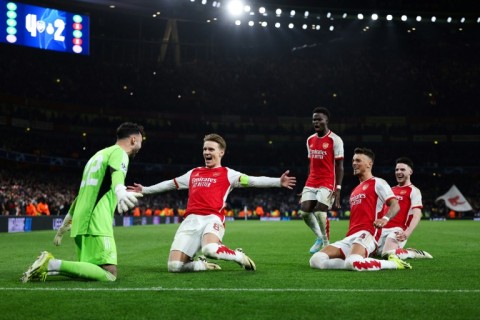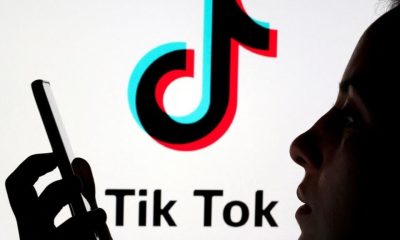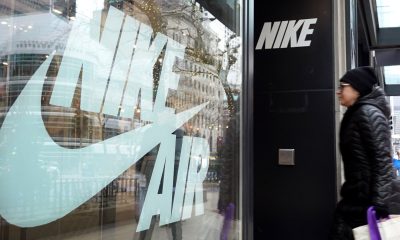Business
EV euphoria is dead. Automakers trumpet consumer choice for U.S. car shoppers

Although consumer demand for EVs hasn’t shown up in the way executives had expected, sales of the vehicles are still predicted to increase in the years to come.
Andrew Merry | Moment | Getty Images
DETROIT — The buzz around electric vehicles is wearing off.
For years, the automotive industry has been in a state of EV euphoria. Automakers trotted out optimistic sales forecasts for electric models and announced ambitious targets for EV growth. Wall Street boosted valuations for legacy automakers and startup entrants alike, based in part on their visions for an EV future.
Now the hype is dwindling, and companies are again cheering consumer choice. Automakers from Ford Motor and General Motors to Mercedes-Benz, Volkswagen, Jaguar Land Rover and Aston Martin are scaling back or delaying their electric vehicle plans.
Even U.S. EV leader Tesla, which is estimated to have accounted for 55% of EV sales in the country in 2023, is bracing for what “may be a notably lower” rate of growth, CEO Elon Musk said in late January.
The broad return to a more mixed offering of vehicles — with lineups of gas-powered vehicles alongside hybrids and fully-electric options — still assumes an all-electric future, eventually, but at a much slower pace of adoption than previously expected.
“What we saw in ’21 and ’22 was a temporary market spike where the demand for EVs really took off,” said Marin Gjaja, chief operating officer for Ford’s EV unit, during a recent interview with CNBC. “It’s still growing but not nearly at the rate we thought it might have in ’21, ’22.”
Ford is significantly increasing its production and sales of hybrid models, which can help ease the transition to electrified vehicles for drivers who may not be ready for fully electric models. They can also help companies meet tighter federal standards for carbon emissions.
GM, which was the first traditional automaker to go all in on EVs, plans to roll out plug-in hybrid electric vehicles for consumers alongside EVs and gas cars. Others, such as Hyundai Motor, Kia, Toyota Motor and, potentially, Volkswagen, plan to offer different levels of electrification across their lineups.
“I think the balanced approach is the best way,” VW of America CEO Pablo Di Si told CNBC last month, adding he is in discussions to bring hybrid vehicles to the U.S. The automaker currently sells hybrid vehicles in Europe, but none stateside.
A VW ID.BUZZ EV vehicle
Scott Mlyn | CNBC
“These technologies exist within the VW group, whether it’s hybrids or plug-in hybrids,” he said. “I think it’s just a matter of time until we bring it here.”
To be clear, although consumer demand for EVs hasn’t shown up in the way executives had expected, sales of the vehicles are still predicted to increase in the years to come.
U.S. EV sales were a record 1.2 million units last year, representing 7.6% of the overall national market, Cox Automotive estimates. That share is expected to increase to between 30% and 39% by the end of the decade, according to analyst forecasts.
“The market was never going to make a smooth transition to EVs, and we expected a slowdown in this shift as early adopters were satisfied,” said Sam Fiorani, vice president of global vehicle forecasting at AutoForecast Solutions. “Moving on to less tech-savvy buyers will slow the EV market share growth over the next few years.”
EV targets
As ESG investing — or investing geared toward environmental, social and governance principles — emerged in recent years and as Tesla rose from niche EV player to the most valued automaker by market cap globally in 2020, the automotive industry largely took note and began plotting its path forward in EVs.
Automakers wanted to emulate Tesla’s success, with some promising to exclusively offer EVs in the not-too-distant future.
Five-year stock comparison between Tesla,and the “Big Three” automakers.
Among those targets: Stellantis-owned Alfa Romeo said its vehicle lineup would be all-electric by 2027. Jaguar Land Rover and Volvo said the same but by 2030. GM said it would offer only electric consumer vehicles by 2035, with its brands Buick and Cadillac aiming to exclusively offer EVs five years sooner. Honda Motor set its target to exclusively sell EVs and fuel-cell-powered vehicles in North America by 2040. Other, more specialized brands such as Lotus and Bentley have also announced EV-exclusive targets.
While none of those automakers has officially announced changes to its long-term goals, there’s been a notable shift in tone and messaging around their goals. Companies are monitoring consumer adoption, global emissions regulations and EV charging infrastructure to determine future plans, officials have said.
Since first adopting an all-electric deadline, of sorts, in January 2021, GM CEO Mary Barra and other executives have more recently said customer demand will steer its efforts. They maintain that the 2035 goal remains its guiding plan. Cadillac now says it will offer a full lineup of EVs, but not necessarily end production of all gas-powered models by 2030.
“We have the best of both worlds right now,” Cadillac Vice President John Roth said last month during an interview. “We’ll see where it heads here in the future, but we are still committed to offering a full EV portfolio by the end of the decade.”
Ford, for its part, has never stated plans to exclusively offer EVs globally, but it did set targets to be all-electric in Europe by 2030, for 50% of its sales in North America to be electric by that same year and to achieve an 8% EV profit margin by 2026. It has since backed off many targets and is cranking out hybrids — specifically trucks — along with EVs and plug-in hybrid electric vehicles for the U.S.
“We’ve always had a freedom-of-choice kind of approach,” Gjaja said. “Some of that was to protect ourselves against going too far in one direction, because the market right now, as we’ve seen, is very uncertain.”
Ford Motor Co., CEO Jim Farley gives the thumbs up sign before announcing Ford Motor will partner with Chinese-based, Amperex Technology, to build an all-electric vehicle battery plant in Marshall, Michigan, during a press conference in Romulus, Michigan February 13, 2023.
Rebecca Cook | Reuters
CEO Oliver Blume during Porsche’s annual media event Tuesday said the German sports carmaker is “in a flexible position” regarding its vehicle manufacturing. He said the company is monitoring EV adoption and regulations but still has a goal of EVs making up 80% of its global sales by 2030.
“We have to keep tabs on it … although the ramp-up is slower than planned last year, we are always in a position to respond flexibly,” he said, adding the company will “have to see in 2026 and 2027” regarding its plans to significantly reduce spending on gas-powered vehicles.
The widespread shift in sentiment brings more automakers closer to the ethos of Toyota. Led by Chairman and former CEO Akio Toyoda, the world’s top-selling automaker has argued for years that a diversified lineup was the right strategy to meet all customer needs and reach its goal of being carbon-neutral by 2050.
The Japanese automaker is now expected to reap the benefits of its strategy, which includes hybrids, plug-in hybrids, EVs and hydrogen fuel cells.
“Toyota is almost completely absent from the [battery electric vehicle] market yet will gain more U.S. market share than any other car company this year. Let that sink in,” Morgan Stanley analyst Adam Jonas wrote in an investor note last week. “EVs may be ‘the future’ but are struggling in the present. Hybrid sales are growing 5x faster than EVs in the US.”
What happened?
After significant interest from early EV adopters — bolstered by low interest rates and Tesla’s rise — interest rates skyrocketed, raw materials costs surged and the vehicles became much more expensive compared with their traditional counterparts.
It’s also become clear that the automotive industry and the Biden administration, which set its own target for half of new U.S. vehicle sales to be electric by 2030, overestimated the willingness of consumers to adopt a new technology without a reliable and prevalent charging infrastructure.
U.S. President Joe Biden gestures after driving a Hummer EV during a tour at the General Motors ‘Factory ZERO’ electric vehicle assembly plant in Detroit, Michigan, November 17, 2021.
Jonathan Ernst | Reuters
The adoption curve of EVs rapidly went through first adopters and some “EV curious” consumers, but has been a tougher sell with mainstream buyers.
“The expectations for EV growth in the U.S. market have shifted from ‘rosy to reality’ as sales increase, but customer acceptance of EVs isn’t keeping pace,” Cox Automotive said in its 2024 forecast report.
The available inventory of EVs in the U.S., measured in days’ supply, has ballooned to 136 days, according to Cox. That compares to the overall U.S. industry at a 78 days’ supply of new vehicles. The data excludes Tesla, Rivian and other automakers that sell directly to consumers rather than through franchised dealers.
“A few years ago, there were wildly ambitious ideas of how EV sales would go and it seemed like nobody was thinking about bumps in this road,” said Michelle Krebs, an executive analyst at Cox. “Now they’re here, and so reality has set in.”
The slower adoption of EVs has led to price cuts or discounts on several models such as the Ford Mustang Mach-E, Tesla Model Y and, most recently, the Nissan Ariya.
Trisha Jung, senior director of Nissan U.S. EV strategy and transformation, said the cuts of up to $6,000 will “improve the model’s competitiveness and ensure we are delivering maximum value to our customers.”
What’s next?
Industry strategy with regard to EVs may shift even more drastically in the months ahead, depending on political pressures, including the finalization of U.S. Environmental Protection Agency fuel economy and emissions standards.
A driving force behind the rollout of EVs by traditional automakers, particularly the so-called Detroit Three, was the need to meet federal vehicle emissions and fuel economy requirements to avoid costly penalties.
Proposals currently under review by the Biden administration to hike fuel economy standards through 2032 could cost automakers more than $14 billion in fines based on the fuel efficiencies of their current fleets, according to the Alliance for Automotive Innovation, which represents the largest automakers operating in the U.S.
Cars make their way in traffic on a Los Angeles freeway on January 25, 2024.
Frederic J. Brown | AFP | Getty Images
A separate letter to federal regulators last year by the American Automotive Policy Council estimated such regulations would cost GM $6.5 billion in fines and Jeep parent Stellantis $3 billion. The council, which represents the Detroit automakers, said Ford’s penalties would total about $1 billion.
Shifting strategy comes with its own costs: Automakers that invested heavily in EV infrastructure and have since changed course could face write-downs or higher capital needs to shore up different production lines. But without consumer sales, they’re left with little option.
It’s unclear how much hybrids and plug-in hybrids would help automakers to meet the potential regulations, given the standards were crafted with a fast EV adoption in mind. But the automakers’ product mix will need to satisfy federal guidelines to remain a viable path forward.
Automakers’ fuel economies are based on a fleetwide mix of vehicles sold. The better fuel economy and fewer emissions a vehicle produces, the better it is for the automaker’s overall score.
“It all depends on what the final regulation looks like,” said Matt Blunt, president of the American Automotive Policy Council.
Blunt said the trade group hopes the Biden administration listens to the industry’s concerns and “understands that a part of transitioning to electric vehicles is having a reasonable fuel economy regulation in place.”
Biden is reportedly expected to dial back certain targets amid the slower-than-expected pace of EV adoption, which was a major piece of his plans to combat climate change.
Looming in the distance, too, is the U.S. presidential election in November. If former President Donald Trump is reelected, he’s expected to scale back or remove the fuel economy mandates, as he did during his first term in office.
A reversal of those standards come January could pave the way for an even longer era of gas-powered and hybrid models.
Automakers operating in Europe face stricter governmental EV regulations, which currently aim to ban sales of traditional, fossil-fuel vehicles by 2035. However, changes have already been made to the regulations and conservative groups such as the European People’s Party have called for dropping the ban.
Business
Ink House Zimbabwe: The Pinnacle of Print Excellence

In the heart of Zimbabwe’s bustling creative industry stands a beacon of innovation and quality: Ink House Zimbabwe. Renowned for its exceptional service and unparalleled craftsmanship, Ink House Zimbabwe has established itself as a leader in the print media landscape.
From the intricate designs that grace corporate branding materials to the vibrant inks that bring life to every print, Ink House Zimbabwe’s dedication to excellence is evident. Their commitment to quick service and awesome ink chemistry on all prints sets them apart, ensuring every client’s vision is not just met, but exceeded.
At Ink House Zimbabwe, it’s not just about printing; it’s about creating lasting impressions. Whether it’s through their meticulous graphic designing or their bespoke events stationery, they ensure that every piece is a masterpiece worthy of praise.
As you explore their offerings at ink.co.zw, you’ll find a company that doesn’t just speak of quality—they embody it. Ink House Zimbabwe is more than a print media company; it’s a partner in your creative journey, transforming your ideas into tangible works of art that speak volumes.
Join the myriad of satisfied clients who have experienced the magic of Ink House Zimbabwe. Where every print tells a story, and every design is a testament to the awesome work they do. Ink House Zimbabwe is not just printing; it’s printing redefined.
Business
Fones 4 Africa: Where Quality Meets Affordability

In the bustling world of technology, finding a reliable source for premium mobile phones and accessories can be a daunting task. However, fear not! Fones 4 Africa has emerged as a beacon of excellence, offering top-notch products at unbeatable prices. Let’s delve into what makes Fones 4 Africa a standout choice for tech enthusiasts.
Premium Phones at Unbeatable Prices
At Fones 4 Africa, quality meets affordability. Whether you’re eyeing the latest iPhone or a cutting-edge Samsung Galaxy, this online store has you covered. Here are some highlights:
- Apple iPhone 11: With prices ranging from R 6,499.00 to R 7,299.00, the iPhone 11 combines sleek design with powerful performance. Customers have rated it 3.83 out of 5 stars.
- Apple iPhone X: Priced between R 4,959.00 and R 5,299.00, the iPhone X boasts a stunning display and exceptional camera capabilities. Users have given it a perfect 5-star rating.
- Apple iPhone XS Max: For those who crave a larger screen, the XS Max (R 5,499.00 – R 6,999.00) delivers. Its 4.56 out of 5-star rating speaks volumes.
- Samsung Galaxy S21 Ultra: If Android is your preference, the S21 Ultra (R 8,499.00 – R 9,599.00) impresses with its camera prowess and sleek design (rated 4.7 out of 5 stars).
- Samsung Galaxy A70 (128GB): A budget-friendly option, the A70 (R 4,999.00 – R 5,099.00) strikes a balance between performance and price (rated 4.6 out of 5 stars).
- Apple iPhone XS: The XS (R 5,999.00 – R 6,399.00) continues to be a favorite among Apple enthusiasts, earning a perfect 5-star rating.
Seamless Shopping Experience
Fones 4 Africa understands the importance of convenience. Their user-friendly website allows you to shop on the go. Plus, with free shipping, you can enjoy your new gadget without any hassle.
Conclusion
In a world where technology evolves rapidly, Fones 4 Africa stands firm as a reliable partner for all your mobile needs. From premium phones to accessories, their commitment to quality and affordability is unwavering. Visit Fones.co.za today and experience excellence firsthand!
Disclaimer: This article is based on publicly available information and reflects positive aspects of Fones 4 Africa. Individual experiences may vary, but we celebrate the brand’s dedication to customer satisfaction.
Business
Raya is shootout hero as Arsenal reach Champions League quarters

LONDON – David Raya was the hero as Arsenal beat Porto 4-2 on penalties on Tuesday to reach the Champions League quarter-finals for the first time since 2010.
The teams were locked at 1-1 on aggregate after an absorbing second leg at the Emirates but Raya saved twice in the shootout to break the hearts of the two-time champions.
The goalkeeper dived full stretch to deny Wendell and repeated the feat against Galeno, while the home side converted all four of their penalties as the decibel count soared.
It is the first time a Champions League match has been decided by penalties since the 2016 final between Real Madrid and Atletico Madrid.
“You are very nervous, you are hoping for the best but you know that it (the shootout) is a bit of a lottery,” Arsenal manager Mikel Arteta told TNT Sports.
“So happy. It has been 14 years (without reaching quarter-finals), which is a long time for a club like Arsenal and it shows how difficult it was. We really had to dig in to find the magic moment at the end.”
“We’ve been patient, worked so hard and a lot of people have made good decisions and showed courage in difficult moments and this is where you want to be,” he added.
Raya, on loan from Brentford, said it was a “great moment personally and collectively”.
“This means everything. You play football for these kind of things and I’m lucky to be playing for Arsenal, to be in the Champions League and to get through to the quarter-finals.”
Trailing 1-0 from the first leg, Arteta’s Premier League leaders — with 33 goals in their past eight league games — were not at their fluent best against a disciplined Porto side.
Leandro Trossard pulled Arsenal level on aggregate shortly before half-time as their patience paid off.
Sergio Conceicao’s men had succeeded in frustrating the home team for long spells during the opening period, fashioning enough chances of their own make it a nervy night for the expectant fans.
Both sides struggled to settle in a scrappy opening period, with Porto doing their best to slow the game down by taking their time with throw-ins and goal kicks, to the audible frustration of the home crowd.
Arsenal defender Ben White headed over in the fourth minute after the home side’s first sustained attack while captain Martin Odegaard hit the side netting 10 minutes later.
But Porto, who were last crowned European champions under Jose Mourinho in 2004, had a number of openings.
Evanilson whipped a shot at goal from distance that bounced wide and minutes later struck a rising strike that Raya palmed away.
Declan Rice headed just wide and Pepe — the first 41-year-old to play outfield in the Champions League — got the deftest of touches with his head to prevent Kai Havertz from connecting with a White cross at the back post.
– Breakthrough –
The breakthrough finally came in the 41st minute following good work from Odegaard, who jinked past an opponent and fed Trossard with a perfectly weighted low pass into the box.
Trossard calmly hit a right-footed shot past goalkeeper Diogo Costa and into the far corner of the net to ease the tension.
The visitors, who had never won a match in England in 22 previous attempts, started the second half brightly as Arsenal struggled to impose themselves.
Arsenal thought they had doubled their lead midway through the second half when Odegaard dinked the ball into an empty net but the goal was ruled out for a foul by Havertz on Pepe.
Moments later Porto streamed forward and Raya blocked Francisco Conceicao’s shot from the edge of the penalty area.
Arteta threw on Gabriel Jesus in the 83rd minute and the former Manchester City man nearly scored with his first touch.
As Arsenal pushed for a winner, Bukayo Saka produced a trademark curling effort that was punched back into the middle and Odegaard steered the rebound wide when well-placed.
The home side looked the more dangerous in the early stages of extra-time but Porto remained a threat on the break, with substitute Mehdi Taremi curling wide.
Arteta brought on Eddie Nketiah and Oleksandr Zinchenko for the second period of extra time but neither side could find a winner and it went to penalties.
By John Weaver
-

 Politics4 months ago
Politics4 months agoUS House of Representatives overwhelmingly passes TikTok ban bill
-

 Business7 months ago
Business7 months agoThe first minds to be controlled by generative AI will live inside video games
-

 Business7 months ago
Business7 months agoIndia is a ‘perfect’ emerging market for investors, ETF expert suggests
-

 Business7 months ago
Business7 months agoNike sinks 10% after it slashes sales outlook, unveils $2 billion in cost cuts
-
Business7 months ago
3 recent success tips from Mark Cuban, including what to keep in mind if you want to be a millionaire
-

 Business4 months ago
Business4 months agoJustice for AKA and Tibz | Unpacking the Ndimande brothers’ extradition
-

 Politics4 months ago
Politics4 months agoCharles de Gaulle’s eldest son, Philippe de Gaulle, dies aged 102
-

 Business4 months ago
Business4 months agoFones 4 Africa: Where Quality Meets Affordability




